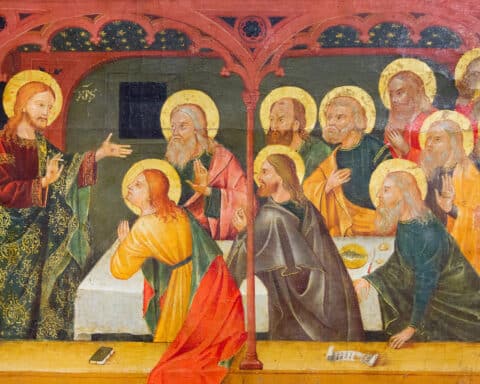The lectionary is composed in such a way that the first reading from the Old Testament — except during the season of Easter when this reading is taken from Acts — functions as a type of image that is fulfilled in the Gospel.
On the feast of the Ascension, something strange happens. The first reading — taken from Acts — depicts the same event as the Gospel of Luke: the Ascension of Christ into heaven. Luke and Acts, although separated in our Bibles, originally were meant to be conceived as a single narrative beginning with the conception of Jesus and concluding with Paul preaching in Rome.
The original Gospel, conceived in the womb of the Virgin Mary, is now preached in the heart of the Roman Empire.
The bridge between Luke and Acts is the moment of the Ascension. Luke ends with the Ascension, while Acts picks up there. Still, the difference between the two accounts reveals something about the meaning of the Ascension in Christian life.
| The Ascension of the Lord – June 2, 2019 |
|---|
|
ACTS 1:1-11 |
Both Luke and Acts open up with an address to a man named Theophilus. It is impossible for us to know the identity of this man, whose name means “friend of God” or “God-lover.” It’s possible that this man existed. It’s also possible that the title is intended for every Christian reader who has become a friend of God through Jesus Christ. In the latter case, the Gospel is written as a direct address to each of us.
In Luke, the Ascension is an occasion of joy. The disciples, drawn together by Jesus, are told once more about the Resurrection, receive a promise of the Holy Spirit and are exhorted to stay in Jerusalem.
Jesus leads them to Bethany, a mile and a half from Jerusalem, then tells them to go back. Having worshipped the Lord and given him homage, they return to Jerusalem full of joy — adoring the Lord in the Temple.
Acts tells the same story, but emphasizes the fear experienced by the disciples. The evangelist provides a summary of what Jesus had said in Luke. But now it is the disciples who are the protagonists of the account.
They want to know if Jesus definitely is going to establish the kingdom. He tells them it is not theirs to know. In Acts, Jesus is depicted as ascending into heaven, disappearing from their presence. Luke mentions an ascent, but Acts is specific — Jesus disappears in a cloud.
A detail is added in Acts not present in Luke. The disciples encounter two men dressed in white, paralleling the moment of the Resurrection. They tell the disciples that Jesus will come again, descending from the clouds.
Acts, therefore, has two significant differences from Luke. First, the main protagonists in Acts are the disciples. Second, Acts promises not just the descent of the Spirit, but also the final appearance of Christ at the end of time.
In Acts, we see a fruitful reflection on the event of the Ascension. The departure of Christ has led to a new age, to the apostolic era in which Christ speaks now through the Church. He is still present; his voice resounds. But today it is not only the apostles, but all of us disciples who proclaim him now.
Likewise, the departure of Christ is not permanent. It is a distance that allows for the increase of faith, hope and love. It is a distance that promises a fuller presence.
Christ will come again. He will descend, dwelling forever among the human family.
The vocation of the Church, as we’ll learn on Pentecost, is to create the right conditions for this dreadfully glorious return.
Timothy P. O’Malley, Ph.D., is director of education at the the McGrath Institute for Church Life at the University of Notre Dame.





